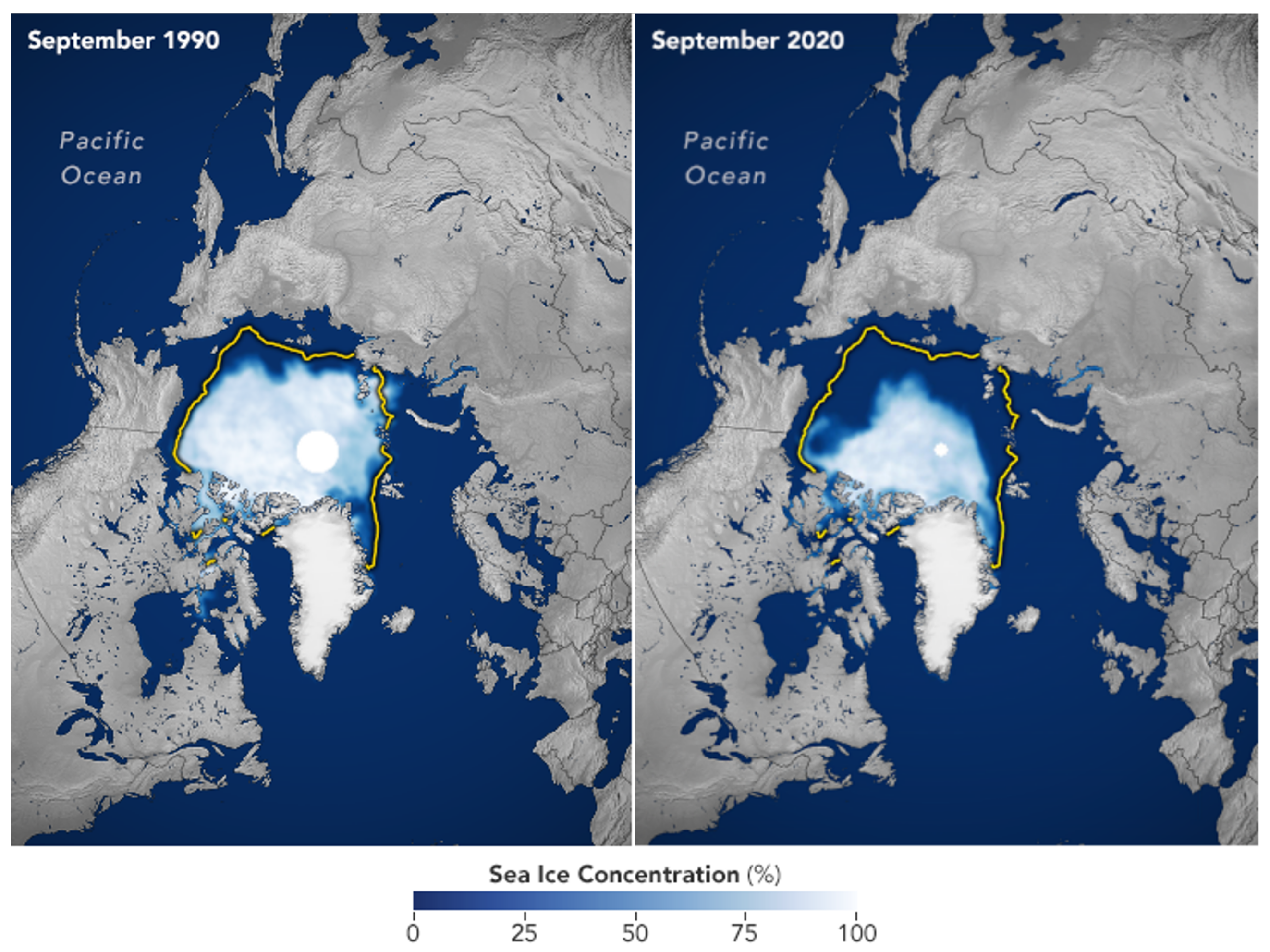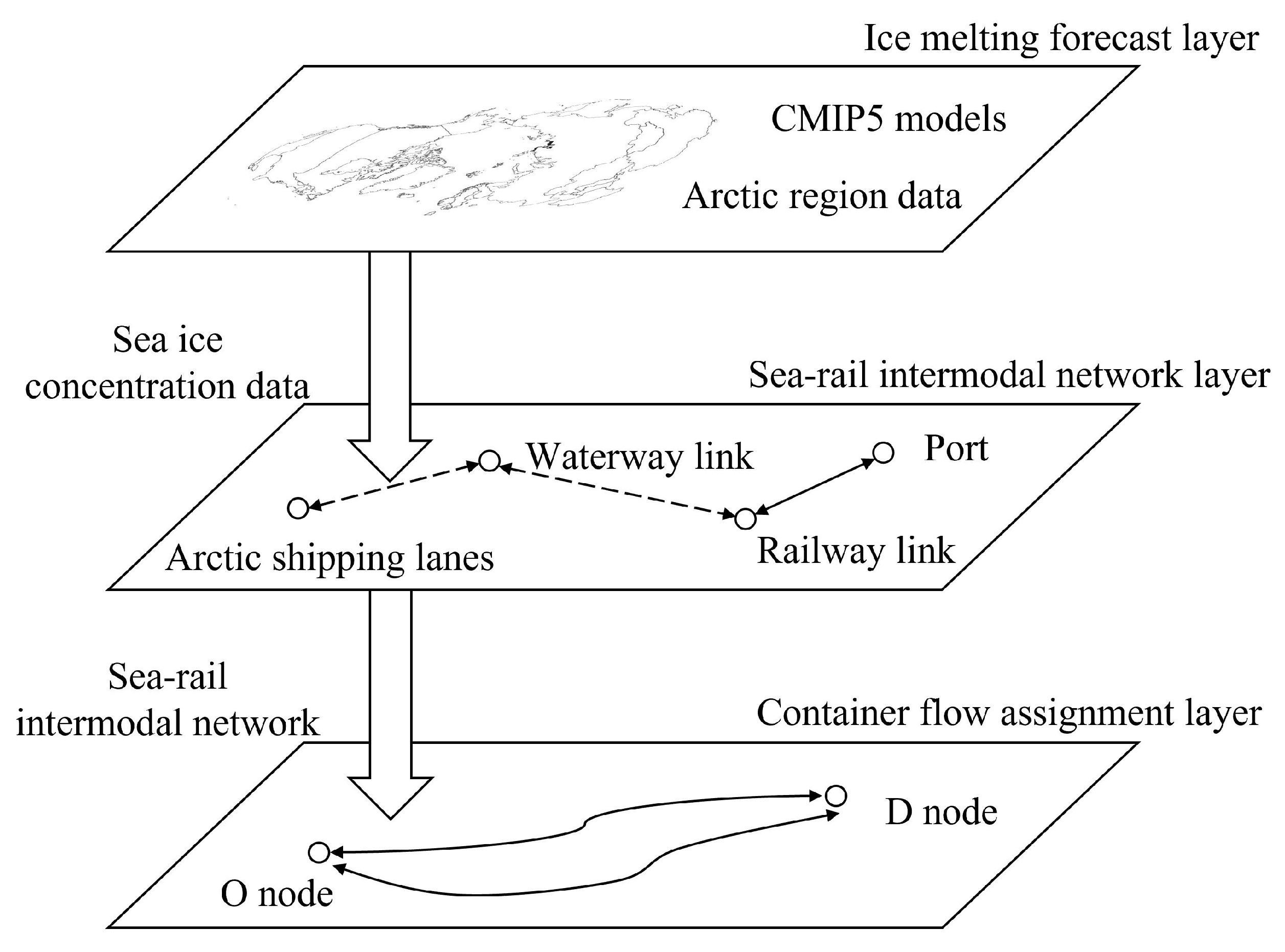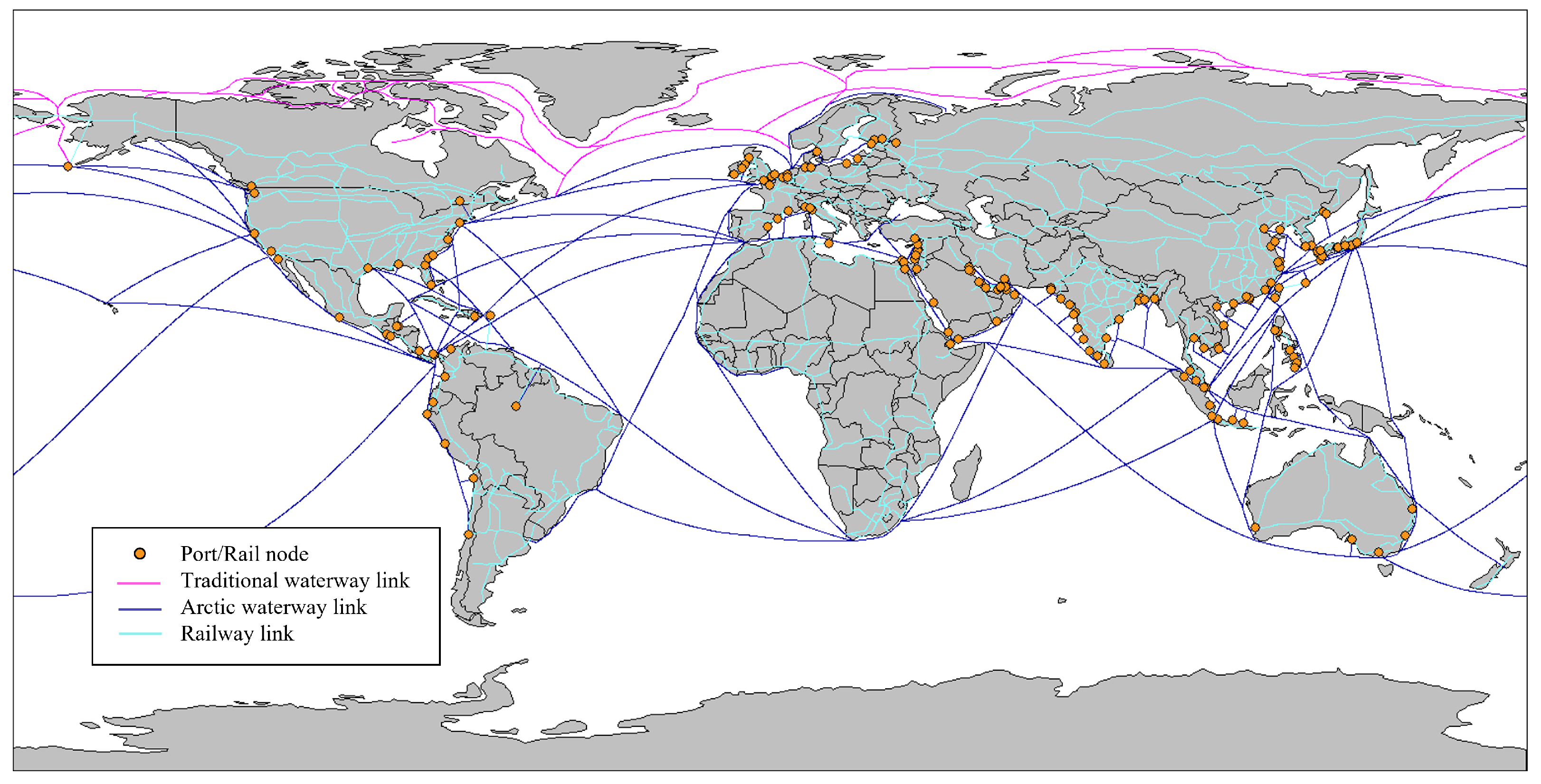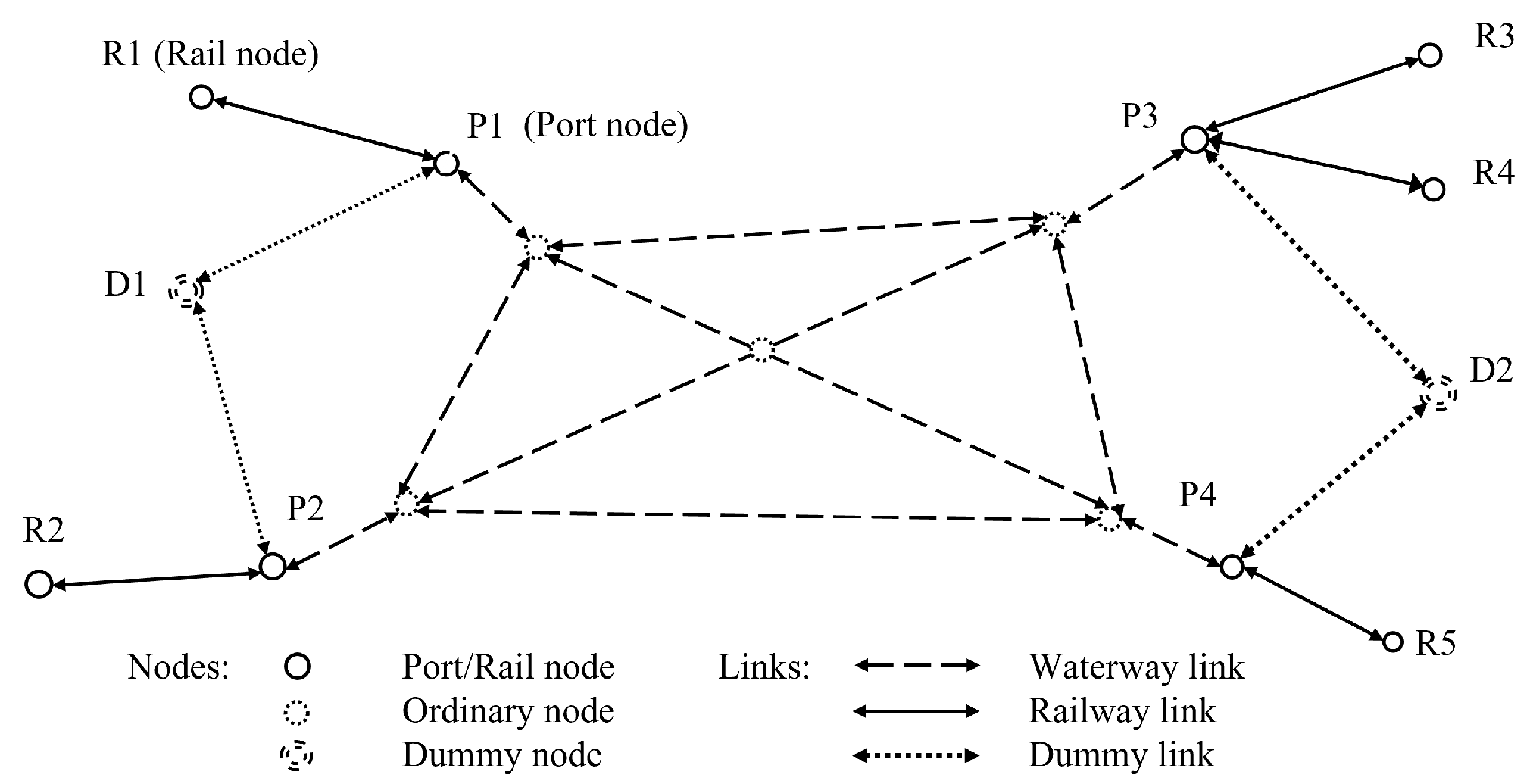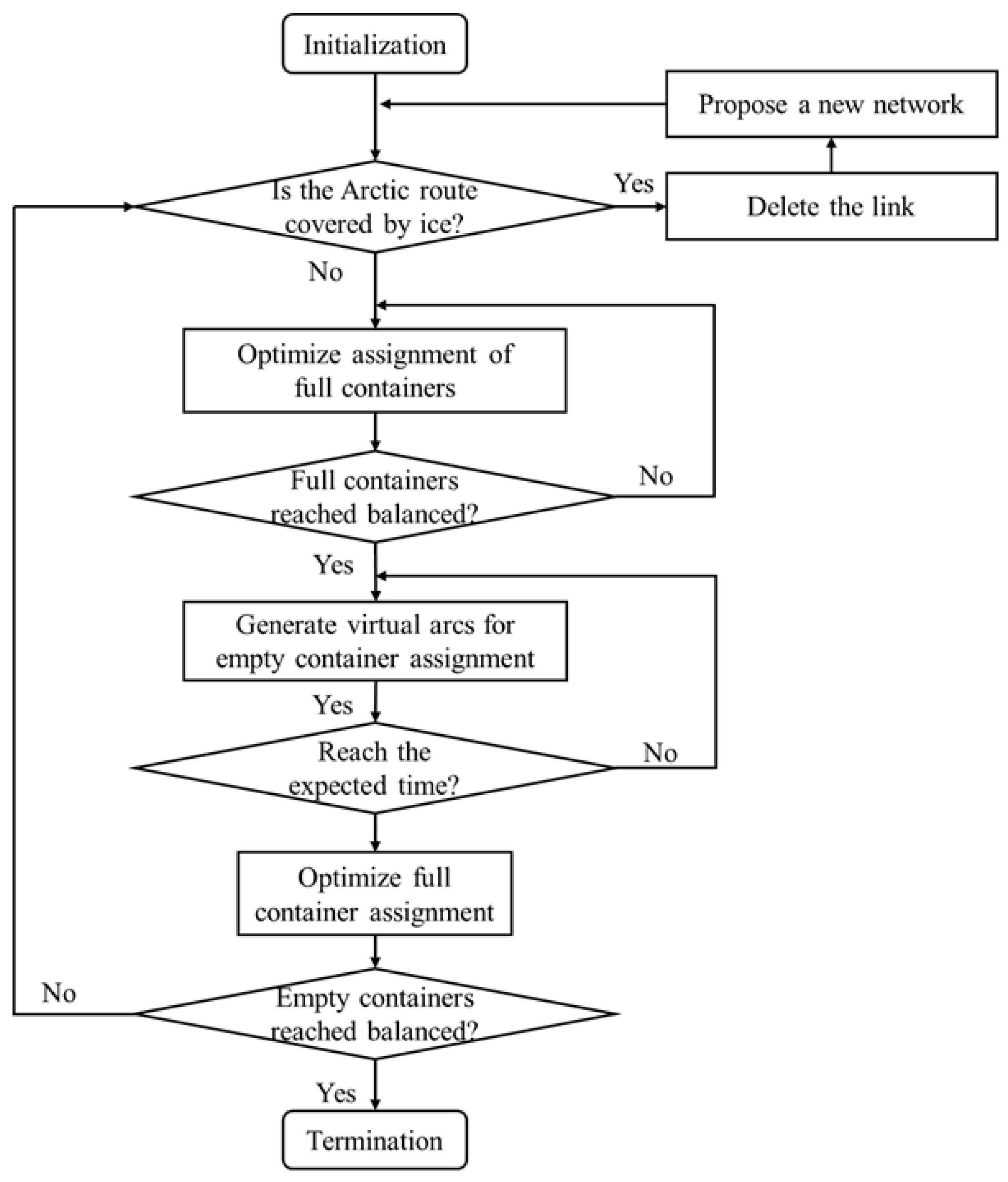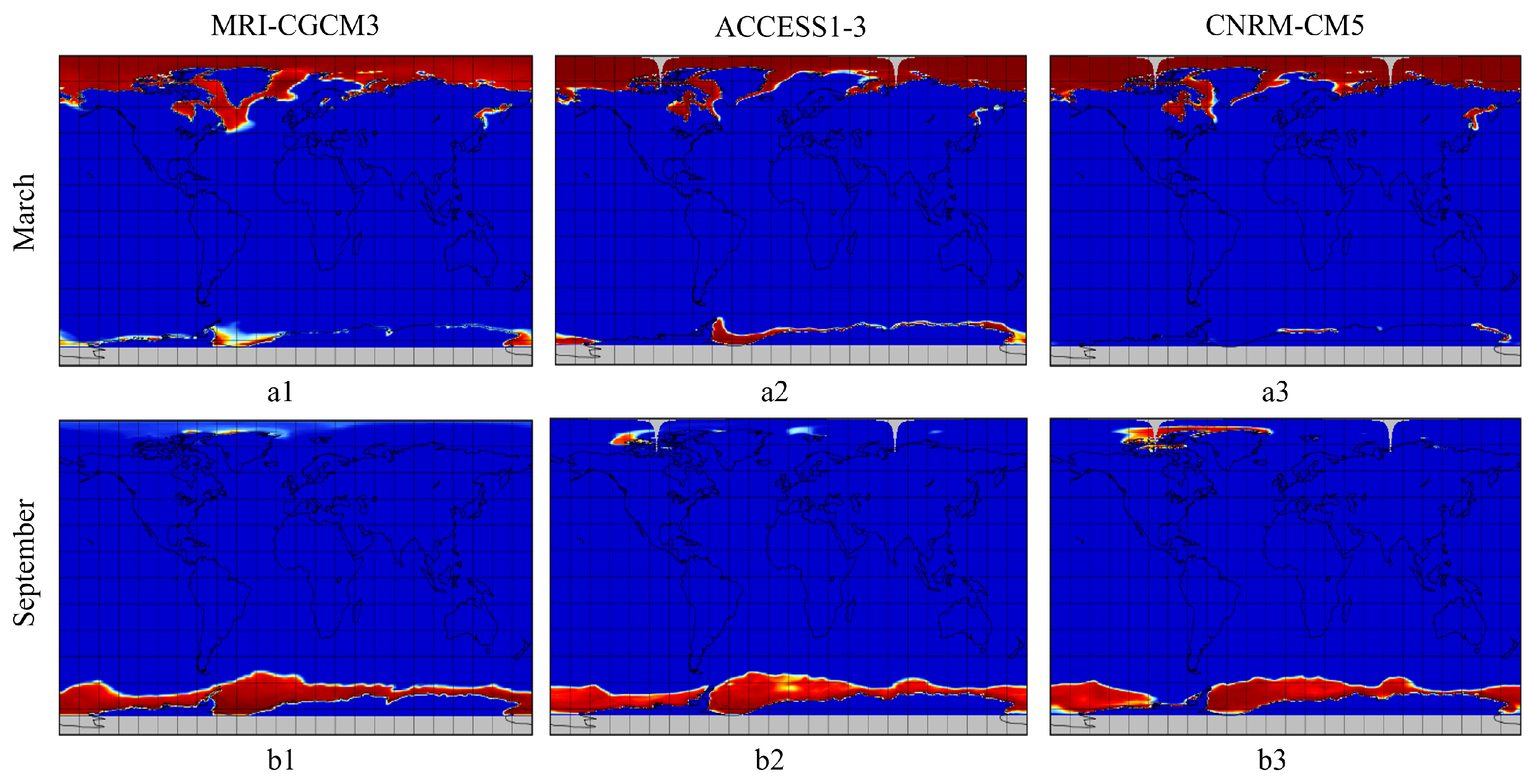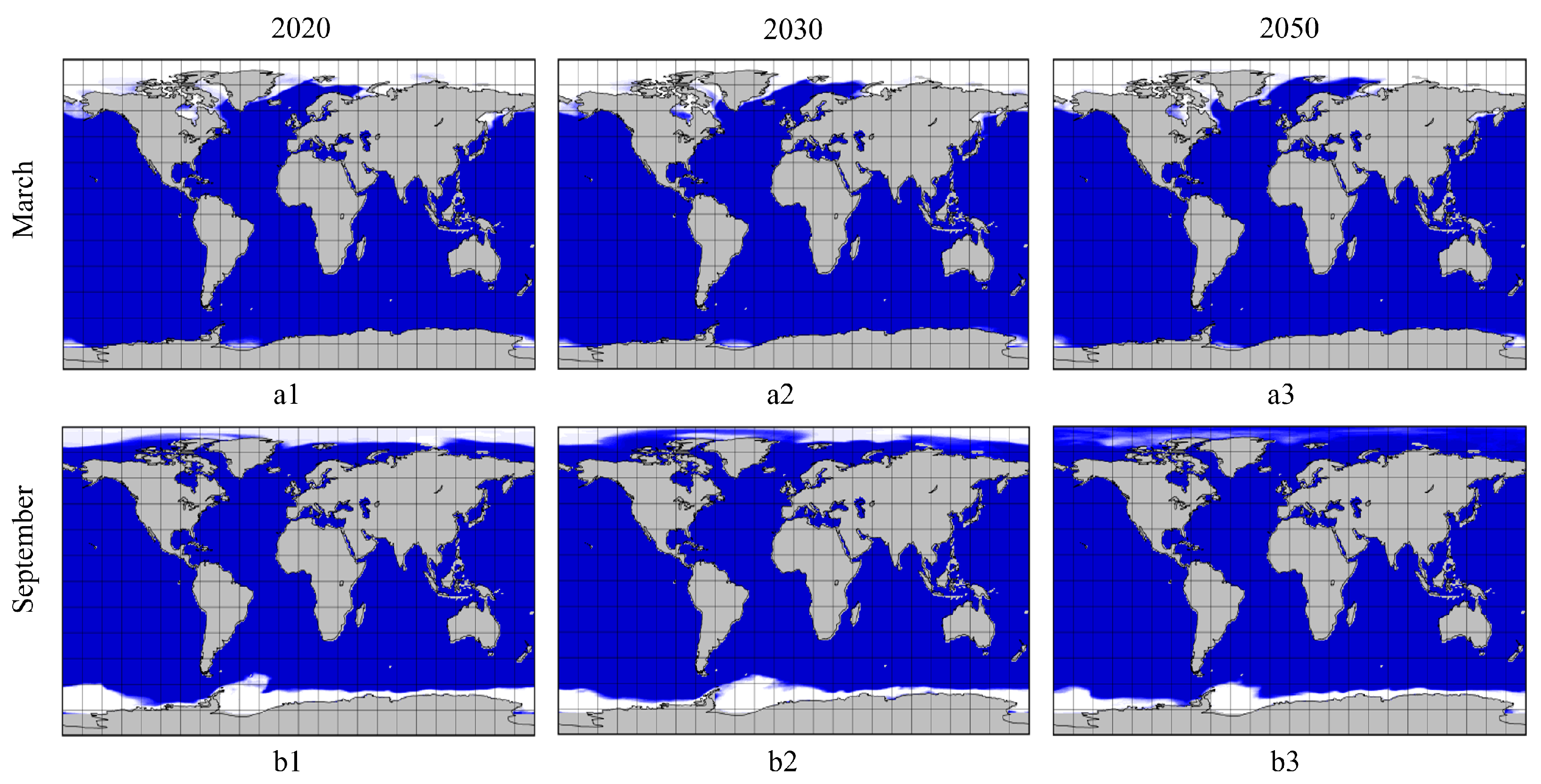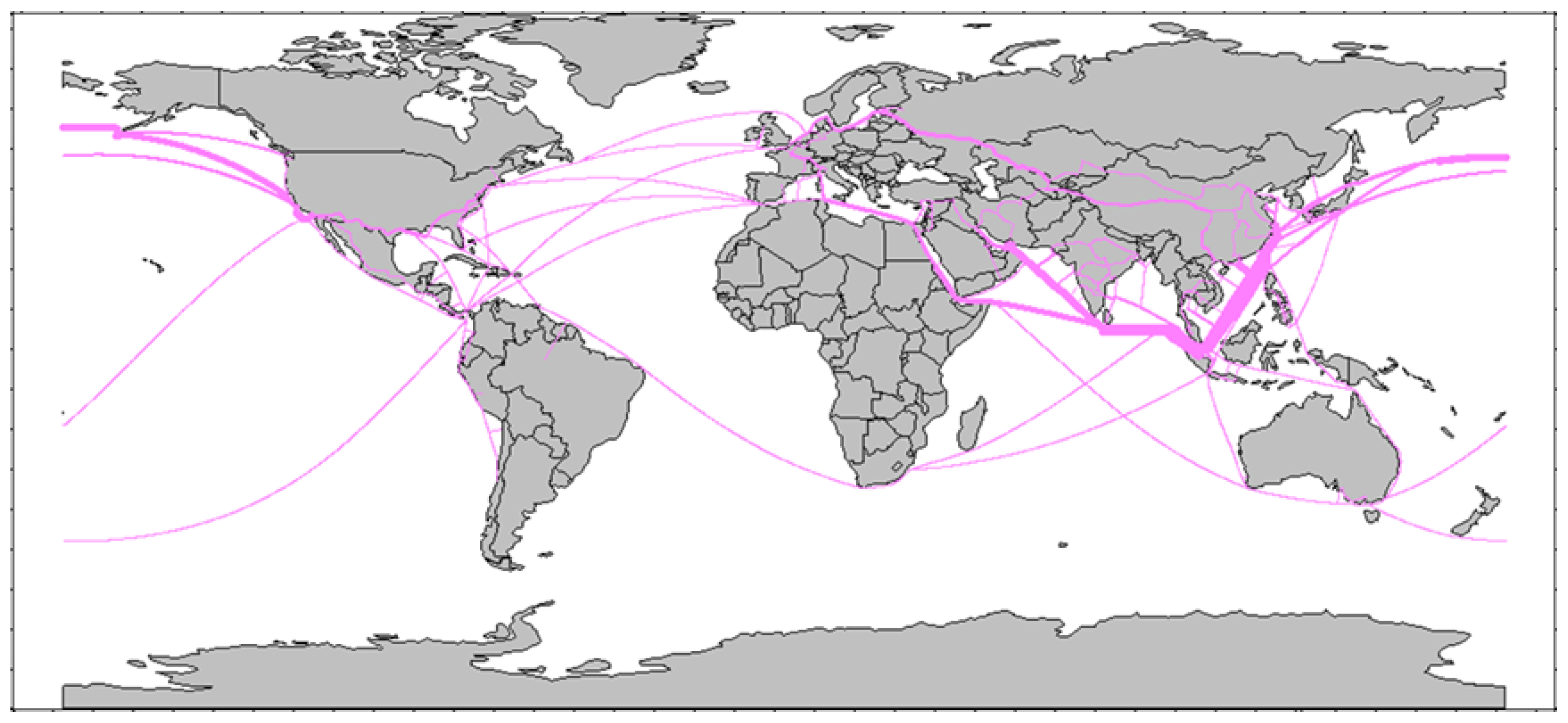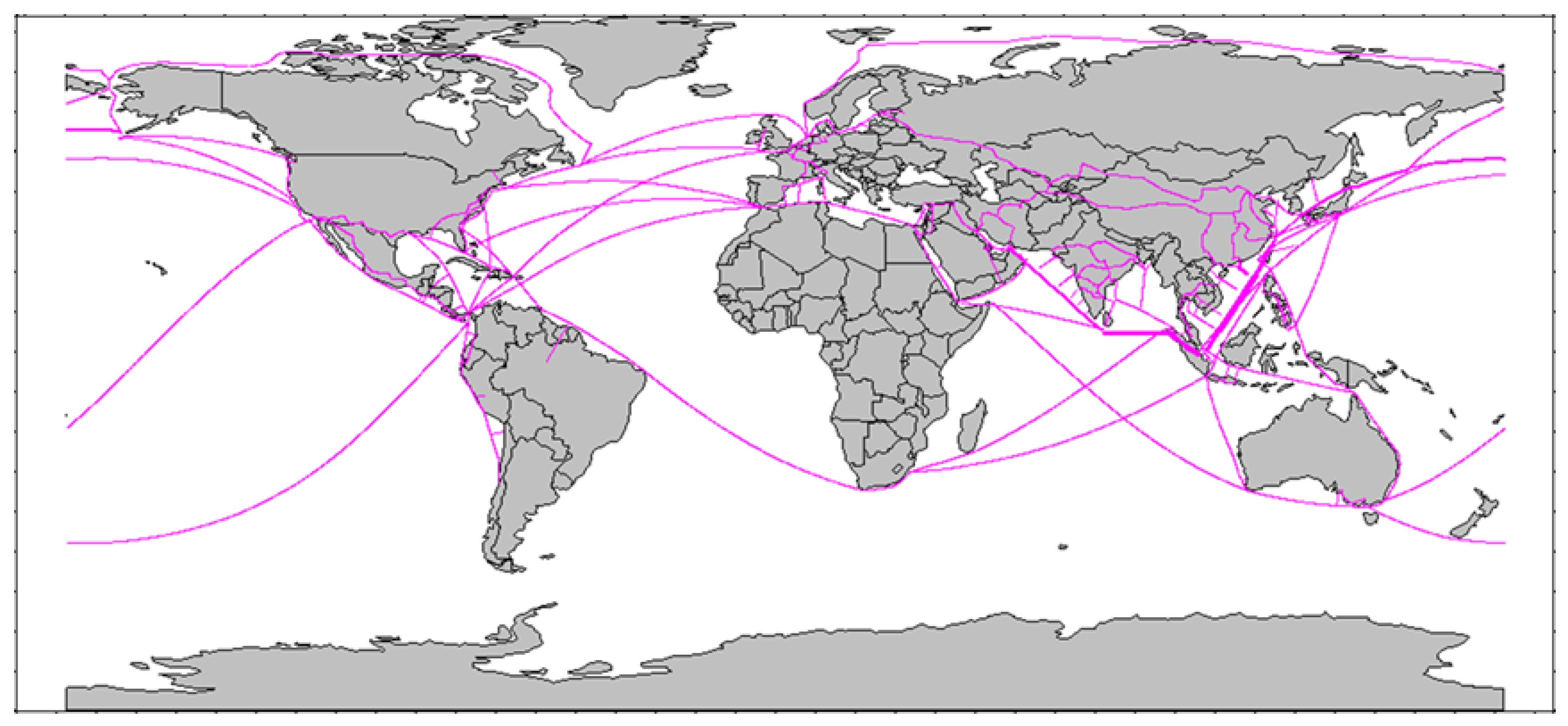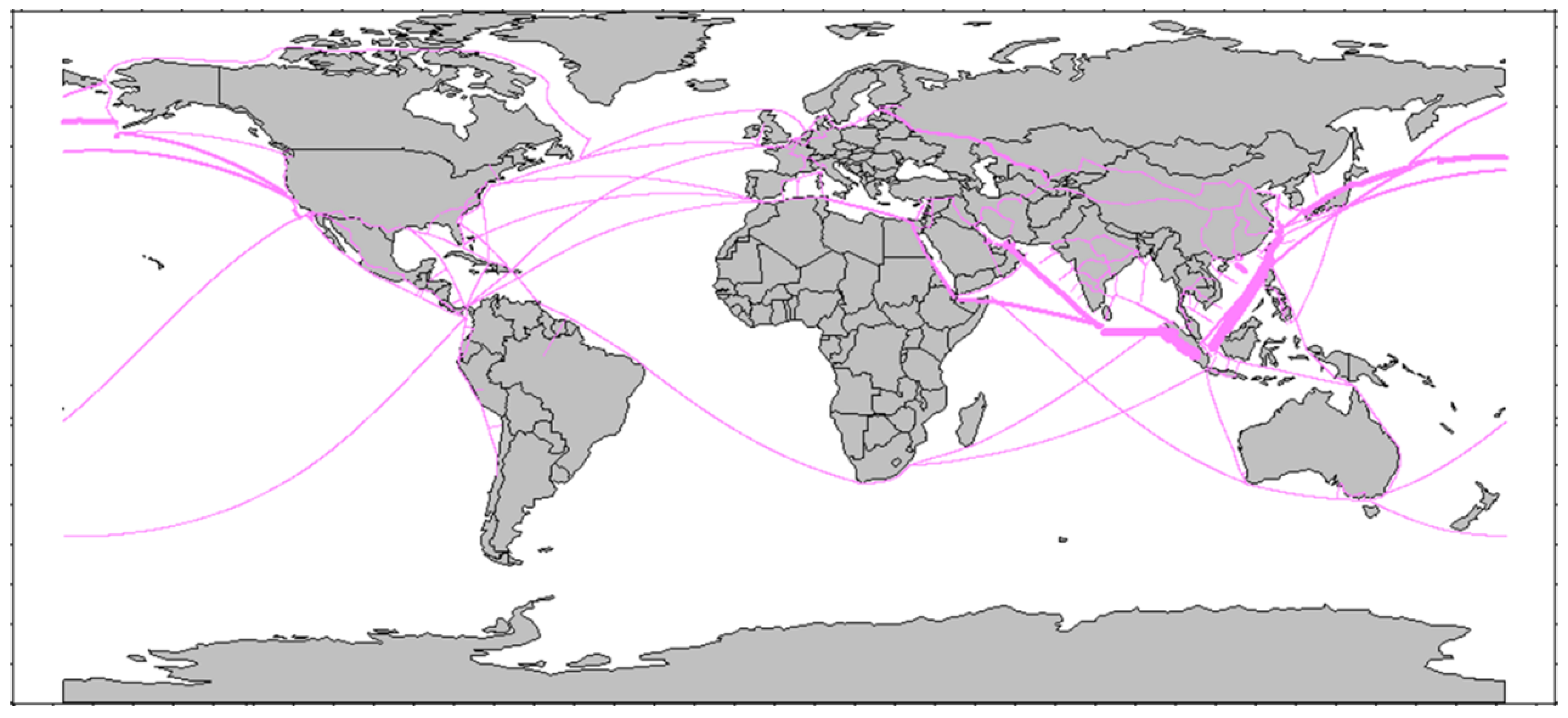1. Introduction
Maritime transport is the most important mode of transportation in international trade and is also a key element in promoting international trade and global economic integration [
1,
2]. According to the United Nations Conference on Trade and Development (UNCTAD), seaborne trade has grown at a compound annual rate of 2.9% over the past 20 years. The total global seaborne trade volume reached 10.7 billion tons in 2020. Meanwhile, container trade volume has been growing annually, reaching 149 million twenty-foot equivalent units (TEUs) in 2020 [
3]. The volume of container trade between East Asia, North America and Europe accounts for nearly 40% of the global container trade. At present, liner shipping companies mainly transport between these regions via the Suez Canal and Panama Canal. As the demand for inter-regional trade continues to grow, the navigational problems of traditional waterways are becoming increasingly apparent. Affected by factors such as waiting time for canal passage, canal tolls and capacity limitations, shipping companies are seeking new routes to replace traditional routes. Transarctic routes shorten the spatial distance between regions, and the potential economic and strategic value of the Arctic routes has received widespread attention from the international community [
4,
5].
Arctic routes consist of two sets of waterways in the Arctic region: the Northern Sea Route (NSR) and the Northwest Passage (NWP). The NSR starts from the Bering Strait in the east and passes through the northern waters of Russia to the Kara Sea in the west, connecting East Asia and Northern Europe. The NWP begins in the Labrador Sea in the east, passes through the Canadian Arctic Islands and ends in the Bering Strait in the west, connecting the Atlantic and Pacific [
4]. Compared to traditional routes, the new routes can shorten sailing distances by up to 40%. When overcoming sea ice obstacles, transportation through the Arctic routes is better than traditional routes in terms of time, cost and safety [
6].
Arctic sea ice melting is continuous and complicated. Satellite mapping shows that Arctic sea ice has exhibited a continuous trend of shrinkage since 1979. Arctic sea ice extent hit record lows several times, and the ice thickness and volume are also decreasing rapidly [
7]. The National Snow and Ice Data Center (NSIDC) report indicated that Arctic sea ice shrank to 4.72 million square kilometers on September 16, 2021, ranking in the bottom 2 of the last 15 years of satellite records.
Figure 1 shows a comparison of sea ice concentrations in September 1990 and September 2020. Dark blue areas are open water. All icy areas have a sea ice concentration of at least 15%, with the highest concentration in the opaque white areas. The yellow outline shows the median sea ice extent in September as observed by satellites. We can see a significant reduction in Arctic sea ice extent in 2020. In addition, climate scenario simulations show that global warming is amplified in the Arctic [
8]. Sea ice melting reduces the albedo of solar radiation in the area, and seawater then absorbs heat more efficiently, thus intensifying the melting of sea ice. Arctic sea ice shrinkage is accelerating due to the combined effects of atmospheric circulation and greenhouse gases [
8,
9]. Meanwhile, Arctic sea ice changes show seasonal characteristics. About 70% of the floating ice in the Arctic consists of seasonal sea ice that grows rapidly during the winter and melts during the summer. Sea ice extent reaches a yearly maximum in March and then gradually decreases to a yearly minimum in September [
10]. The navigable mileage of the Arctic shipping lanes varies under different sea ice conditions constraints. Therefore, it is necessary to examine the sea ice melt trends and the feasibility of Arctic routes under different melt phases.
In recent years, with the continuous improvement and extension of the rail network, the transshipment process between railways and ports has been more convenient, and the volume of sea–rail intermodal transport has gradually been increasing. Sea–rail intermodal transport combines the advantages of both modes and can carry large amounts of cargo with a high network stability [
11,
12]. After the opening of the Arctic routes, the new routes will be connected to the traditional routes as well as to the rail network, forming a new sea–rail shipping network. The new sea–rail network will increase inter-regional connectivity and facilitate international trade exchanges, which will inevitably cause drastic changes in freight traffic in the network. Considering the risk, emission and cost factors, liner companies will adjust their fleet deployment according to the new route network and choose more economical transportation methods [
13,
14,
15]. The problem of Arctic sea–rail container assignment is worth studying, both from an economic and stability point of view. As pointed out earlier, with the continuous reduction of sea ice extent, the Arctic shipping lanes are gradually revealed. Changes in the shipping lanes affect the shipping network and the assignment of freight demand in the network, so it is essential to analyze the changes in the sea–rail intermodal network and the container flow assignment in the context of Arctic ice melting.
Studies on Arctic routes began at the end of the last century and have focused on the history of Arctic navigation, the climate of the Arctic region and international laws related to Arctic navigation [
4,
5]. Until the last decade, studies on the economic value of transarctic transport have emerged, addressing the economic feasibility of Arctic routes and their impact on the economy and trade [
6,
16]. Arctic navigation will change the structure of the maritime network, which will affect freight flows in the network. However, few have considered the impact of Arctic navigation on the container flows in the shipping network. Therefore, this study is motivated to narrow the research gap by answering the following questions: (1) How will the container flows in the global sea–rail shipping network change with the opening of the Arctic routes? (2) Considering the impact of continued sea ice melt on the navigability of the Arctic shipping lanes, what are the trends in container flows on the routes? Hence, the paper aims to examine the impact of continued Arctic ice melt on global container sea–rail network and the container flows in the network. First, we simulate the melting of Arctic glaciers by 2050 using sea ice data from three Coupled Model Intercomparison Project 5 (CMIP5) models under the medium forcing emission scenario (Representative Concentration Pathway (RCP) 4.5). Then, with the melting of sea ice, new navigable shipping lanes are emerging in the Arctic. The new shipping routes can be combined with the existing maritime and rail networks to form a new container sea–rail intermodal network. Finally, we simulate the assignment of container flows in the global sea–rail intermodal network with a concave cost network flow model and solve it with the shortest path algorithm.
Our contribution to the existing literature is mainly twofold. On the one hand, it is one of the few studies in the field of global container transport research that considers the Arctic routes to construct a containerized sea–rail network with global coverage. Moreover, although existing studies have examined the economic feasibility of the Arctic routes, there has been little exploration of freight traffic along the Arctic routes. Our study innovatively considers the Arctic ice melt-based container flow assignment problem to analyze the changes in container flows due to network changes. On the other hand, carriers will choose more economical modes of transportation and adjust their business strategies in the face of new route networks. Our study can provide theoretical implications for carriers. Meanwhile, the calculation results reveal the future trend of freight traffic, which can provide a basis for decision-making for the future planning and development of ports and the country.
The remainder of this paper is organized as follows.
Section 2 reviews the literature on Arctic routes and on the container flow assignment.
Section 3 presents a simulation framework to analyze the impact of sea ice melt on the global containerized sea–rail network and the assignment of container flows.
Section 4 presents the numerical analysis results and discussion. The final section lists conclusions and suggestions for future research.
3. Methodology
In this section, we propose a simulation framework to analyze how global container flows are assigned after the Arctic navigation.
Figure 2 shows the framework structure, containing three layers. In the upper layer, we estimate the future Arctic sea ice concentration based on the atmosphere–ocean coupled models of CMIP5. The obtained sea ice concentration data are transferred to the middle layer as input information to determine whether the transarctic shipping lanes are covered by sea ice. The sea ice melting gradually reveals the shipping lanes and changes the shipping network. In the middle layer, we can get a new global sea–rail intermodal network considering sea ice extent changes. We construct a concave cost network flow model in the lower layer to minimize the total transportation costs. By assigning container demand to the new global sea–rail intermodal network, changes in container flow assignment in the context of Arctic ice melt can be assessed.
3.1. Ice Melting Forecast
Arctic sea ice melting is a complex process. Considering the coupling relationship between sea ice and atmosphere, we estimated the Arctic climate with the help of the CMIP database in this module. The fifth phase of the International Coupling Model Comparison Program has carried out climate analysis under different scenarios through several global atmosphere–ocean coupled models (AOGCMs) in 35 countries, including future short-term climate change projections (to 2035) and future long-term climate change projections (to 2100–2300) [
7]. This paper adopted the global AOGCMs mentioned in the Fifth Assessment Report of the Intergovernmental Panel on Climate Change (IPCC AR5) as the prediction model for Arctic ice melting.
The AOGCM consists of three parts: atmospheric circulation model, the sea ice circulation model and the coupler, which can well reflect the dynamic process of heat exchange between atmosphere and ocean as well as the formation and melting cycle of sea ice. Thus, when using the AOGCMs to study the distribution of ice and snow on the sea surface, it is not only necessary to consider the energy conversion between the sea ice surface and the atmosphere but also the influence of the sea–air flow on the ice and snow, the melting of the sea ice itself and the formation of new ice.
The Representative Concentration Pathways (RCPS) are the emission scenario developed by the IPCC AR5, which was developed to combine climate, atmospheric circulation, carbon emissions and socioeconomic factors to provide a specific analysis of the impacts of climate change in the Arctic [
37]. This paper used the RCP 4.5 typical emission scenario and selected sea ice concentration data from three AOGCMs in CMIP5, MRI-CGCM3, ACCESS1-3 and CNRM-CM5.
Based on the sea ice concentration data output from each model prediction, the dividing line between Arctic seawater and sea ice cover was further determined. To reduce the prediction model error, this paper used the boundary between seawater and sea ice determined by more than 50% of the selected models as the standard and finally determined the edge of sea ice extent.
3.2. Sea–Rail Intermodal Network
To optimize and simulate the assignment of container flows in the global sea–rail intermodal network, we used Microcity to connect the maritime network with the rail network. The network consisted of transport links and port nodes. Some ports had rail transit stations, which were the basis for connecting maritime and rail networks. In addition, the NSR and the NWP were also added to the global sea–rail intermodal network. Then, the entire network was topologically processed to obtain the specific path distance between nodes. To avoid the error between the calculated path distance on the plane and the actual path distance, we used the radian formula to refine the distance data further. Finally, container demand between global ports was obtained from a shipping company, and subsequently, the container demand, shipping distance, passing capacity and other related data of major ports were stored in the global sea–rail intermodal network correspondingly. Since the container flow assignment model considered not only the flow assignment of full containers but also the flow assignment of empty containers, a two-way container shipping network covering both eastbound and westbound was established.
Figure 3 shows the constructed global container sea–rail intermodal network containing the NSR and the NWP. To easily distinguish the routes, different colors are set for different links of the container shipping network, with pink indicating the trans-Arctic links, dark blue indicating the traditional waterway links and light blue indicating the railway links.
3.3. Container Flow Assignment
3.3.1. Problem Description
Arctic routes provide new transport channels for international trade exchanges. Shipping companies can choose Arctic routes for cargo transportation, which will cause changes in cargo flows in the shipping network. To analyze the assignment of global container flows after the opening of Arctic routes, we established a sea–rail intermodal network container flow assignment model from the perspective of transportation cost and aimed at the minimum cost of the whole transportation process for path selection. The model not only considered meeting the cargo demand but also considered the problem of empty container repositioning due to the unbalanced cargo demand between regions.
We constructed a global container sea–rail intermodal network consisting of maritime and rail networks, and its abstract network is shown in
Figure 4. Topologically, the shipping network was described by a graph, denoted by
.
V indicates the set of nodes and
A indicates the set of links in the network. There were three types of nodes: port nodes, ordinary nodes and dummy nodes. It was assumed that the ordinary nodes were the intersections of navigable waterways. Each port node was linked to an ordinary node via a waterway link. Some of the port nodes had transshipment rail nodes within them, and these ports were the linking points between the maritime network and rail network. The full container demands originated and terminated at port nodes. Considering the imbalance between container supply and demand in the network, we added dummy nodes as supply and demand points for excess empty containers to solve the problem of empty container repositioning. The set of links included waterway links, railway links and dummy links. Waterway links connected various ports. Dummy links connected ports and dummy empty container surplus or deficit nodes.
For a better understanding, an an example is given of a shipping network with 10 container demands from port 1 (P1) to port 4 (P4) and 15 container demands from port 2 (P2) to port 3 (P3), respectively. After the container transportation demand is met, port 1 and port 2 will experience empty container demand, while port 3 and port 4 will generate excess empty containers. Thus, empty containers need to be repositioned. The remaining empty containers will be concentrated in dummy node 2 through the dummy link, and all empty container demand will be concentrated in dummy node 1. Thus, the normal OD demand from dummy node 2 to 1 is established. We set the capacity of links D1-P1 and P4-D2 to 10 and the capacity of links D1-P2 and P3-D2 to 15.
To simplify the problem, we propose the following assumptions in this study: (1) It is assumed that the liner shipping company does not have its fleet, and all the ships used for transport come from the charter market. (2) Container types include twenty-foot and forty-foot equivalent unit containers. Full and empty containers are transferred throughout the network to meet the fixed demand between various port nodes. (3) The shipping costs mainly include capital cost and voyage cost. Specifically, charter costs, fuel costs during the voyage and container handling costs are calculated. In the rail network, railway freight is mainly considered. The cost of the dummy link is assumed to be zero. In addition, the transshipment costs of the nodes are not considered. (4) Each link has a capacity limit. The demand of the port determines the capacity of the waterway links connecting to the ports. The capacity of other waterway links is assumed to be very large. The capacity of the dummy links is set to the corresponding excess or shortage of the container volume.
3.3.2. Mathematical Model
For discussion convenience, we summarize the notations used in this paper in
Table 1 below.
Before presenting the mathematical formulation, we first established the network’s cost functions for the waterway and railway links.
Shipping costs in the maritime network include costs incurred during voyages and costs incurred in ports. The model proposed in this paper considered the cost of loading and unloading containers at the port, including both full containers and empty containers. In addition, the voyage cost and charter cost were also considered.
is the charter cost function of the link
,
is the voyage cost function of the link
. The shipping costs
in the network can be expressed as:
Compared to shipping costs, rail costs are much simpler. Since national governments generally set railway freight rates, the principles of calculating the cost of railway costs are uniform. Total freight is the product of container freight rate, weight billed and mileage. Similarly, full containers and empty containers are considered in the railway network. The rail costs
in the network can be expressed as:
The container flow assignment problem can be formulated as follows:
The objective function (3) is the sum of the shipping cost and the railway cost of container shipping. Equations (4) and (5) ensure that each node flow is conserved. Equation (6) limits the container flow of each link to its maximum passing capacity. Equations (7) and (8) restrict the decision variable to be non-negative. Equations (9) and (10) indicate that the node surplus at the origin and destination ports should meet the port’s container demand.
3.4. Solution Method
Based on the shortest path cargo flow assignment method, this paper regarded the transportation cost on each path as impedance and changed the path impedance of different transportation modes, then realized the cargo flow assignment of the global container shipping network. The shortest path cargo flow assignment method is not constrained by conditions such as geographical limitations and path capacity. It usually assigns the cargo flow demand between all ports to the corresponding shortest path of the cargo flow in the shipping network. The shortest path cargo flow assignment method is more convenient and faster than the mathematical model cargo flow assignment method in dealing with large-scale shipping networks’ cargo flow assignment problems. In addition, this method is consistent with the empirical fact that trains and ships on railways and waterways mostly choose the shortest route for transportation.
The planning and simulation of the container flow assignment of the network were carried out in line with the specific process design shown in
Figure 5.
Step 0: Establish a global container shipping network based on the current shipping network and container demand between ports. In the initial step of the simulation, the Arctic sea ice extent in March 2020 is used as the initial state, and the time interval is six months. Based on the temporal variation of Arctic ice melt, the system generates Arctic Sea ice extent every six months based on the predicted data.
Step 1: Determine whether the Arctic route is covered by sea ice based on the sea ice extent. If the Arctic route is blocked, go to Step 2. Otherwise, it is proved that the Arctic route is navigable and repeat Step 1 until all Arctic routes are reviewed. Then, go to Step 3.
Step 2: When the Arctic route is covered by sea ice and is not navigable, this route is deleted, and a new container shipping network is generated.
Step 3: Based on the established model, the flow assignment is performed separately for full containers and empty containers. When the demand for empty and full containers reaches equilibrium among all ports, the result of container flow assignment under Arctic sea ice extent is output, and then go to Step 4.
Step 4: Determine whether the forecast period is reached (September 2050). If the expected time is not reached, return to Step 0. Otherwise, terminate the procedure and report the results.
5. Conclusions
Arctic sea ice is melting at an accelerated rate due to climate warming, and it is a key factor limiting the Arctic navigation. The progressive opening of Arctic shipping lanes will change the layout of the maritime network, which in turn will affect the container flows in the network. This paper investigated the container flow assignment in the global sea–rail intermodal shipping network under the change of Arctic sea ice. To solve the above problem, we simulated future changes in sea ice extent using the CMIP5 models, proposed a network flow assignment model to simulate the assignment of container flows in the new global sea–rail intermodal network and solved it with an algorithm.
Our results introduced the following conclusions. First, from the transportation cost side, the opening of the Arctic routes will reduce the total global container transportation costs by 0.5%, which can bring more competitiveness to container shipping enterprises. Secondly, the Arctic routes will compete with traditional routes and share the container flows in traditional routes. Waterways such as the Straits of Malacca and the Suez Canal will be the most negatively impacted, with a significant reduction in container traffic. Thirdly, besides the important impact on the maritime network, the Arctic navigation also leads to a reduction in container flow on the rail network. Compared to the maritime network, the rail network is less affected. Taking the Eurasian Land Bridge as an example, its container flow will be reduced by about 12% after the opening of the Arctic routes. Finally, because the Arctic routes are still severely constrained by ice and snow in winter, and the seasonality of navigation is obvious, the proportion of container flows undertaken in the global container shipping network is still very limited. However, with global warming, the sailing time of the Arctic routes will be expected to be extended annually. The impact of the Arctic routes on the global container shipping network will continue to expand.
Theoretically, our paper considered the feasibility of Arctic navigability after the melting of sea ice, established a global container sea–rail intermodal shipping network including the Arctic routes and assigned the container flow based on the shipping network. In practice, our research can provide valuable management insights for liner shipping companies, port operators and government decision-makers. Specifically, liner companies should make timely adjustments to the shipping network according to the navigability of the Arctic shipping lanes. According to the characteristics of the Arctic shipping lanes at different periods, liner companies can consider deploying different capacities and vessel sizes to reduce transportation costs by using transarctic transportation. For port operators, the Arctic navigation will change the freight flow in the global shipping network, and the port throughput will change with it. The hub position of the southern hemisphere ports will be challenged by the northern ports due to the northward shift of container traffic after the opening of the Arctic routes. For the ports that may benefit from the Arctic routes, they should accelerate the improvement of the sea–rail shipping network of the ports and actively play a transportation hub function. For ports with declining freight volumes, such as Singapore and Penang, they should adjust their port development strategies in time to actively face the economic impact of changes in network traffic. The Arctic route will shorten the distance of maritime trade and increase the efficiency of inter-regional transport. The governments can pursue their strategic interests in the Arctic region and strategically position themselves for a better use of the Arctic routes to facilitate trade development.
It should be noted that the study has some limitations and needs to be improved in future studies. On the one hand, this study did not consider the passage capacity of the shipping lanes. We only analyzed whether the Arctic routes could be opened as sea ice melts. In practice, the extent of Arctic ice melt affects the width of the Arctic shipping lanes, and thus limits the volume of cargo passing through. Further research on Arctic shipping capacity will help to consider the problem of cargo flow in the Arctic more realistically. On the other hand, this study simplified the calculation of transportation costs. We only considered the main container transportation costs, while the actual transportation cost factors are more complex. Future studies need to further refine the classification of transportation costs to consider factors such as container transshipment costs, Arctic route transit costs, etc.
